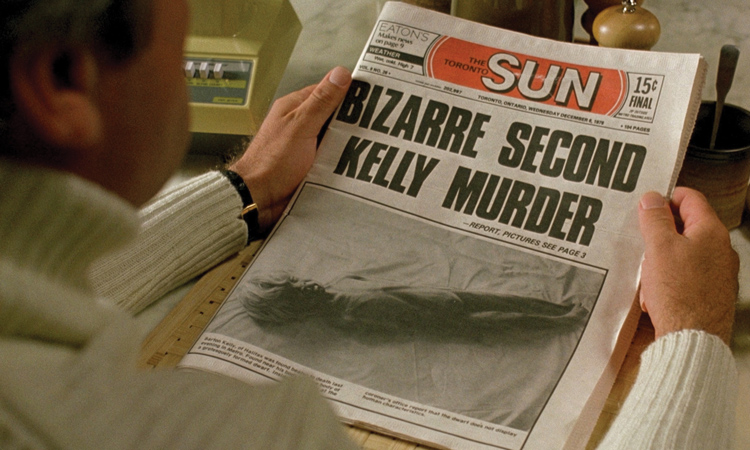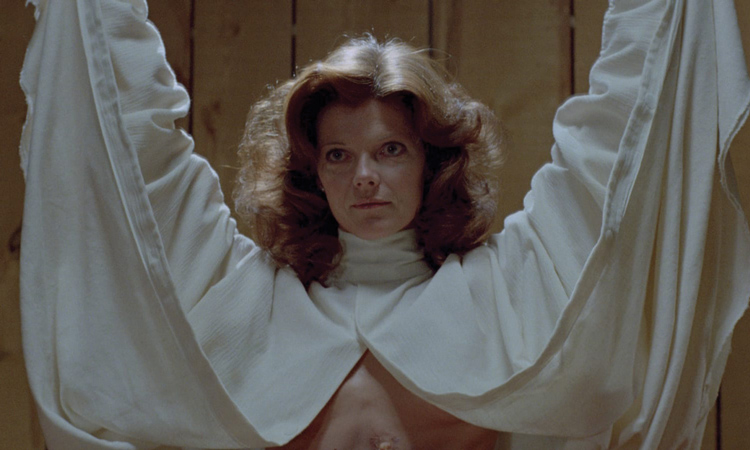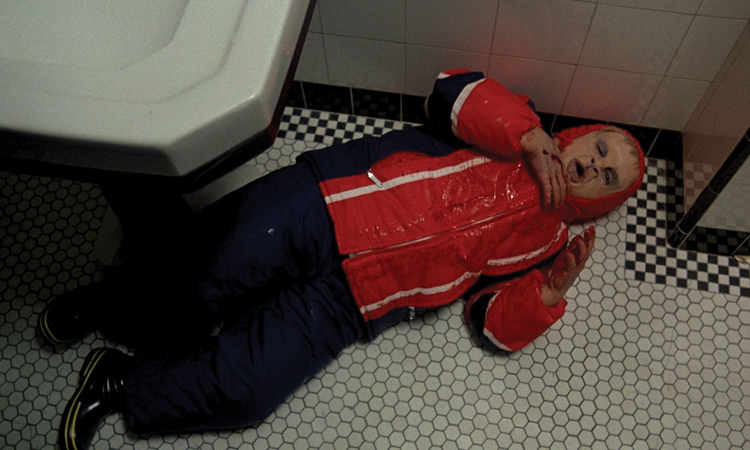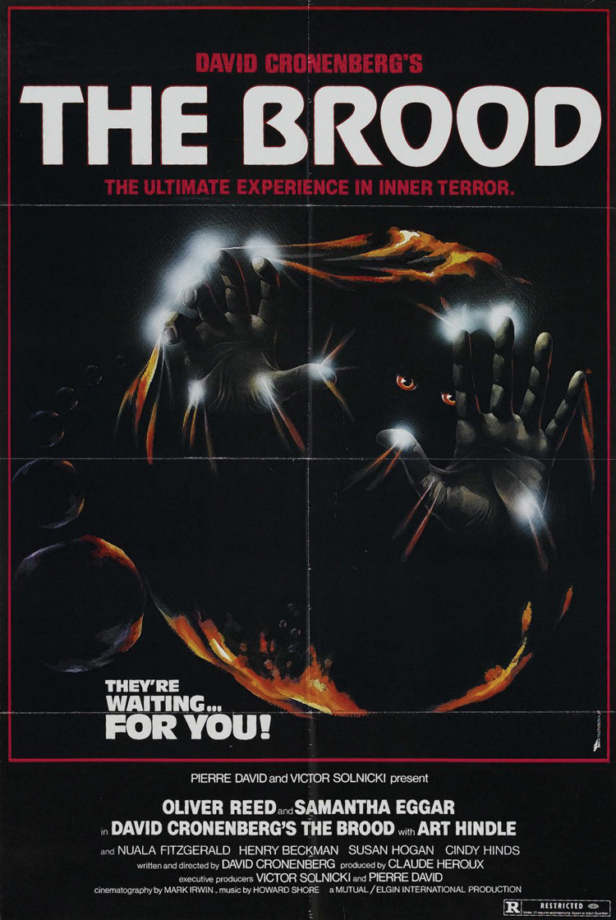The Brood is the brainchild of writer-director David Cronenberg. Over forty years on it arguably remains the former body horror director’s most personal movie. It concerns the struggles of a divorced father to protect his six-year-old daughter, by uncovering the unorthodox treatments being administered upon his institutionalised ex-wife and how this could all be connected to a series of gruesome murders.
It was written during a particularly turbulent time for the filmmaker, whom had himself recently gone through a harrowing divorce and subsequent custody battle for his own daughter, after she was abducted and placed into a cult by his ex-wife. Cronenberg claimed The Brood was his more truthful take on Kramer Vs Kramer – the Oscar-winning divorce drama that he viewed as a comparatively lifeless commentary on the subject.
Following experimental curios Stereo and Crimes Of The Future, along with eyebrow-raising body horror exploitation flicks Shivers and Rabid, 1979’s The Brood, (Cronenberg’s first bonafide studio film) also marked a distinct turning point for the reigning ‘king of venereal horror’.
“David seemed to be hitting a new stride because up until then it had been kind of gooey horror films,” director-of-photography Mark Irwin tells SciFiNow. “This was the first stand up one, which was more dramatically-based and not so special effects based. I think he was coming-of-age like the rest of us.”

Indeed, following drag-racing drama Fast Company, this was the first of five bonafide director-cinematographer collaborations between Irwin and Cronenberg – a successful partnership that subsequently encompassed other horror masterpieces like Scanners, Videodrome, The Dead Zone and The Fly.
Adding a touch of gravitas (and indeed notoriety) was legendary British actor Oliver Reed as renegade psychologist Dr Raglan, who practices the controversial metaphysical therapy of ‘psychoplasmics’ on his patients, which involves the physical manifestation of rage. “[He] played the perfect overbearing kind of domineering master of all and David really investigated a lot in him and his performance,” continues Irwin. “Ollie was not the kind of guy who would listen necessarily but he respected David very much as he had written the screenplay.”
Indeed, it’s a typically commanding performance from Reed, yet working with the notoriously temperamental actor (and functioning alcoholic) had its challenges, not least for the actor himself, who was tackling his own demons at the time.
“He had a bodyguard, who was also his stand-in and he would help him with his lines very closely – working back and forth,” continues Irwin. “Whenever David would have [script changes] Ollie would get very ‘RADA’ on everyone. It turned out that Ollie was dyslexic, so his smokescreen and that kind of bluff that he would call when there were script changes on the spot, was to call everyone an amateur.”
Reed’s scenes with British actress Samantha Eggar, who played his patient Lola, the troubled wife of Frank Carveth (Art Hindle), remain some of the most powerful. Irwin suggests this intense chemistry was enhanced by a romantic history the two British actors had shared. “He had worked with Eggar when they were both much younger and they had had somewhat of a jilted romance so Ollie, late at night would be knocking on her door… it was good in a way that they were uncomfortable onset.”
Lead actor Art Hindle, who was involved in some of the most distressing scenes depicted, recalls The Brood as being a particularly tough shoot. “Every scene I was in was just gruesome and very intense,” he tells SciFiNow. “You have the kindergarten murder with the [killer brood] and working with a little girl who played my daughter Candice, and all the acting things that she had to go through – she was terrific but working with children is very ‘duck and dodge’.”

Hindle’s reference to the brutal teacher attack scene is particularly pertinent, as its shocking power remains intact four decades on – especially as the kids appear to be witnessing the violently staged murder before their very eyes.
Irwin assures us, however, that it was all shot under purposely-jovial circumstances. “David had a light touch when it came to that scene – not that it was a frivolous scene but he was aware of Candice’s age, who was the same age as his own daughter, and so he was very light and playful with these kids,” he offers. “David and the first AD really went out of their way to ensure it wasn’t portrayed as something lethal at all. When it’s all cut together of course it is, but the kids didn’t experience any trauma from it.”
Equally unsettling to watch is an earlier daytime kitchen murder scene straight out of the Hitchcock rulebook of suspense. The scene carefully builds tension through a succession of omniscient shots, then, teasingly refuses to fully reveal the looming antagonistic threat, before spilling into a brutal murder montage attack that keeps audiences on tenterhooks.
However, it could have all turned out quite differently: “The scene was very structured and the reason it was cut so selectively was due to the same problem Spielberg had on ET, which was that the on-camera talent didn’t give what [the director] wanted,” continues Irwin. “In retrospect it’s a lot better cut together like this; if you save up the thrill you can build people’s expectations, so it ended up being much more dramatic than it would have been if something was running, jumping and smashing people to pieces!”
We eventually learn that the deformed children who are undertaking these violent murders are actually motivated by Nola’s anger – being manifestations from her subconscious. The climatic scene where Oliver Reed has to contend with the brood hauled up in an isolated bunkhouse, proved equally intense – not just for viewers.
“It was very uncomfortable for the kids [who played the brood]. They were a young gymnastic team of girls aged five to eight and they had never been on a film set before. Ollie was quite loud and they were quite frightened,” remembers Irwin. “What made it worse was these [masks] they had on would not come off easily and so they had to eat lunch with these masks on, so they were all bent out of shape.”
The scene in question sees Dr Raglan go to the bunkhouse in an attempt to safely retrieve Frank’s daughter Candice from the clutches of the titular brood. However, they begin to get agitated by his presence and progressively start hissing and lashing out. “These kids wanted nothing to do with Oliver Reed! He smelt like a distillery and was yelling, so these kids were not going to jump on him, much less attack or go near him!” reveals Irwin.
The production team attempted to address the problem by darkening the set with shadows and panels that carefully concealed the kids’ parents, who were in fact hidden off-screen, behind the bunk beds in order to assist their children. “There was a kid on the top bunk shaking in fear as Ollie would come down this aisle,” continues Irwin. “The kids’ parents were very helpful and they kind of launched their children at Ollie, who would grab them, use them as living dolls and attack himself. So, when you look at the scene now it’s very [choppily edited] because it was hard to get things to flow.”
Art Hindle had sound reason to get the heebie-jeebies too during the filming of an earlier autopsy scene: “We actually shot in an actual autopsy room in a real hospital – where we look at the dead fetus of one of these things.
“We had finished what we intended to do, then David said to me: ‘Why don’t we grab a shot where [you’re] coming through the door? Just go out that door and we’ll frame it and then you come in.’ So, I went out there, closed the door and I’m waiting and waiting for action… then suddenly I felt funny, turned around and realised this was kind of a storage room for corpses! So, then I was waiting for action and for some reason there was a delay, tweaking a light or something like that and it seemed like I was in there for hours!”
However, the actor was able to make light of his experiences working on a Cronenberg movie. “I always joke that the most directing that I heard David do on The Brood was after he looked at a scene, his only comment would be ‘more blood!’” laughs the actor. “In fact I had a special T-shirt made at the end as a wrap gift with the words: ‘More Blood!’ with blood dripping on it!”

Cindy Hinds, the brave child actor who portrayed his tormented daughter Candice, was also fortunately left unscathed by the experience working on The Brood. “David found a way for her to channel fear. Once she’s screaming I don’t think he did any tricks like not telling her what was going to happen,” assures Irwin. “He really went the distance with her and it was a really close partnership and bond that they had.”
Mark Irwin believes The Brood was quite a therapeutic experience for the director at the time, who was perhaps venting a lot of his own demons on-screen. “David has a bachelor of science in medicine and is one of the few directors I know who has a degree in something other than filmmaking,” he says. “So, the gooey things about medicine, life and about death are things that sort of appeal to him and I’m glad he was working on his demons on the films that I did with him. Any inner trauma he had he put in the script and then in the movie. There’s nothing better than that kind of therapy!”
The Brood remains a chillingly atmospheric achievement; masterfully maintaining a melancholic mood that carefully builds to an extraordinary climatic crescendo. All the elements that we have come to expect from a classic Cronenberg body horror pic are in place: from a brooding score courtesy of Howard Shore (in his film composing debut), master class cinematography from Mark Irwin, an eclectic cast of actors giving exceptional performances, along with a strong psychological theme that manifests into something grotesquely external and is realised by explicit make up and body horror effects. All of this results in a movie that is deeply cerebral, utterly disturbing and thus a truly unforgettable viewing experience.
The Brood is available on Blu-ray from Second Sight.
